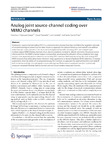Mostrar el registro sencillo del ítem
Analog joint source-channel coding over MIMO channels
| dc.contributor.author | Vázquez-Araújo, Francisco J. | |
| dc.contributor.author | Fresnedo, Óscar | |
| dc.contributor.author | Castedo, Luis | |
| dc.contributor.author | Garcia-Frias, Javier | |
| dc.date.accessioned | 2024-02-19T17:56:17Z | |
| dc.date.available | 2024-02-19T17:56:17Z | |
| dc.date.issued | 2014-02 | |
| dc.identifier.citation | Vazquez-Araujo, F.J., Fresnedo, O., Castedo, L. et al. Analog joint source-channel coding over MIMO channels. J Wireless Com Network 2014, 25 (2014). https://doi.org/10.1186/1687-1499-2014-25 | es_ES |
| dc.identifier.issn | 1687-1499 | |
| dc.identifier.issn | 1687-1472 | |
| dc.identifier.uri | http://hdl.handle.net/2183/35661 | |
| dc.description.abstract | [Abstract]: Analog joint source-channel coding (JSCC) is a communication strategy that does not follow the separation principle of conventional digital systems but has been shown to approach the optimal distortion-cost tradeoff over additive white Gaussian noise channels. In this work, we investigate the feasibility of analog JSCC over multiple-input multiple-output (MIMO) fading channels. Since, due to complexity constraints, directly recovering the analog source information from the MIMO channel output is not possible, we propose the utilization of low-complexity two-stage receivers that separately perform detection and analog JSCC maximum likelihood decoding. We study analog JSCC MIMO receivers that utilize either linear minimum mean square error or decision feedback MIMO detection. Computer experiments show the ability of the proposed analog JSCC receivers to approach the optimal distortion-cost tradeoff both in the low and high channel signal-to-noise ratio regimes. Performance is analyzed over both synthetically computer-generated Rayleigh fading channels and real indoor wireless measured channels. | es_ES |
| dc.description.sponsorship | This work has been funded by Xunta de Galicia, MINECO of Spain, and FEDER funds of the EU under grants 2012/287, TEC2010-19545-C04-01, and CSD2008-00010; and by NSF award CIF-0915800. | es_ES |
| dc.description.sponsorship | Xunta de Galicia; CN 2012/287 | es_ES |
| dc.description.sponsorship | United States. National Science Foundation; CIF-0915800 | es_ES |
| dc.language.iso | eng | es_ES |
| dc.publisher | SpringerOpen & European Association for Signal Processing | es_ES |
| dc.relation | info:eu-repo/grantAgreement/MICINN/Plan Nacional de I+D+i 2008-2011/TEC2010-19545-C04-01/ES/ESTRATEGIAS COOPERATIVAS Y COGNITIVAS PARA LA GESTION DE INTERFERENCIAS EN REDES DE COMUNICACIONES INALAMBRICAS/ | es_ES |
| dc.relation | info:eu-repo/grantAgreement/MICINN/Plan Nacional de I+D+i 2008-2011/CSD2008-00010/ES/FOUNDATIONS AND METHODOLOGIES FOR FUTURE COMMUNICATION AND SENSOR NETWORKS/ | es_ES |
| dc.relation.uri | https://doi.org/10.1186/1687-1499-2014-25 | es_ES |
| dc.rights | Atribución 3.0 España | es_ES |
| dc.rights.uri | http://creativecommons.org/licenses/by/3.0/es/ | * |
| dc.subject | Fading Channel | es_ES |
| dc.subject | MIMO Channel | es_ES |
| dc.subject | Additive White Gaussian Noise Channel | es_ES |
| dc.subject | Minimum Mean Square Error | es_ES |
| dc.subject | Linear Minimum Mean Square Error | es_ES |
| dc.title | Analog joint source-channel coding over MIMO channels | es_ES |
| dc.type | info:eu-repo/semantics/article | es_ES |
| dc.rights.access | info:eu-repo/semantics/openAccess | es_ES |
| UDC.journalTitle | EURASIP Journal on Wireless Communications and Networking | es_ES |
| UDC.volume | 25 | es_ES |
| UDC.startPage | 1 | es_ES |
| UDC.endPage | 10 | es_ES |
| dc.identifier.doi | 10.1186/1687-1499-2014-25 |
Ficheros en el ítem
Este ítem aparece en la(s) siguiente(s) colección(ones)
-
GI-GTEC - Artigos [193]






